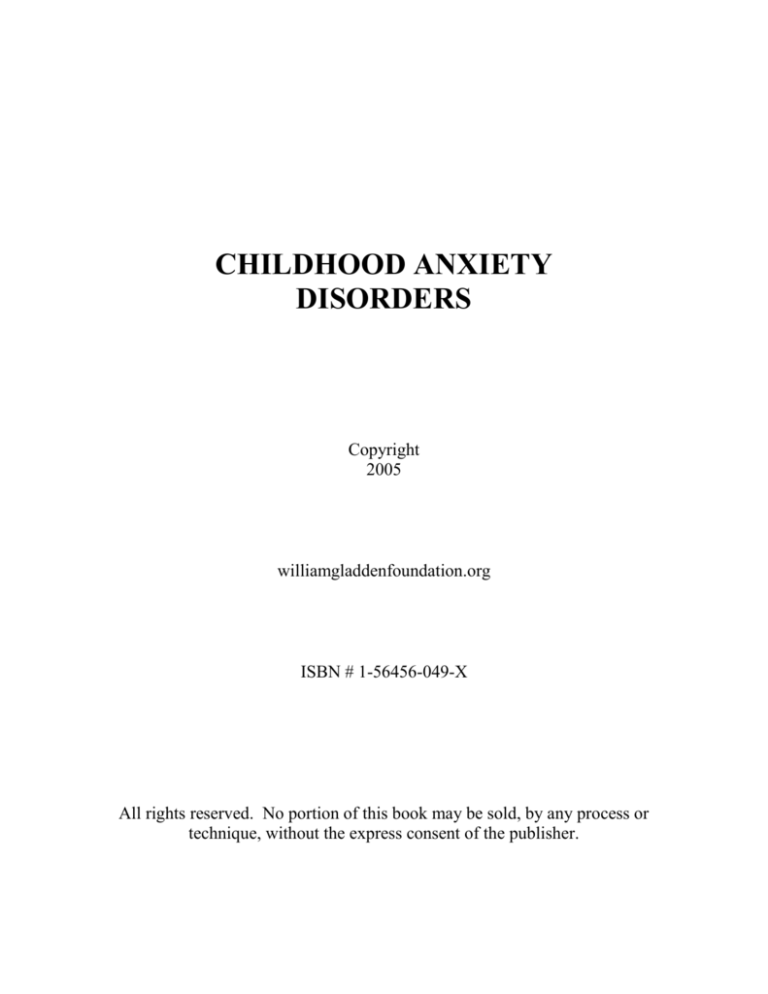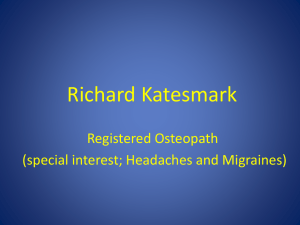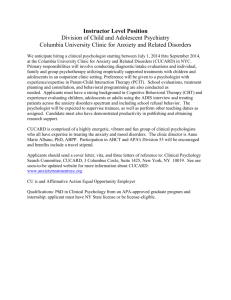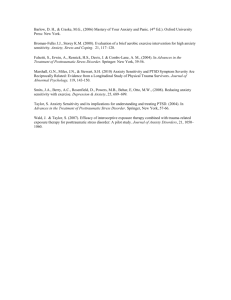
CHILDHOOD ANXIETY
DISORDERS
Copyright
2005
williamgladdenfoundation.org
ISBN # 1-56456-049-X
All rights reserved. No portion of this book may be sold, by any process or
technique, without the express consent of the publisher.
INTRODUCTION
The research on mental illness shows that anxiety disorders are quite common. For
example, adults with one or more anxiety disorder are the largest group of mentally ill
persons in this country. Furthermore, an estimated 30 million Americans suffer from
anxiety disorders, including children.
The onset of adult anxiety disorders frequently occurs during childhood. About half the
affected adults develop anxiety before age 15, which indicates there may be as many as
15 million American children with anxiety disorders.
We now understand that substance abuse and mental disorders, both in children and
adults, often co-exist and make each disorder more serious and more difficult to treat.
We also recognize that suicide by children is on the rise and that children who do commit
suicide often have treatable mental illnesses, including anxiety disorders.
The need for early detection and effective treatment of anxiety disorders is obvious.
There are ways to ease the needless suffering of these children, thereby preventing the
growth of developmental or educational deficits, poor self-esteem and social disability.
There is also a high probability that much adult disability and suffering is preventable if
the problem is recognized and treated before the illness can entrench itself and become
chronic.
-II-
Given this information, it is especially prudent and important to focus attention on the
anxiety disorders of childhood. The purpose of this publication is to provide information
about the causes, effects, treatment and management of childhood anxiety disorders,
including ways to identify these children. We hope that the information outlined in the
following pages will furnish readers with a more complete understanding of how to help
children who may be suffering from anxiety disorders, and prevent these problems from
continuing into adulthood.
Cyma J. Siegel, R.N.
Waln K. Brown, Ph.D.
William Gladden Foundation
-III-
TABLE OF CONTENTS
QUESTIONS AND ANSWERS
What Are The Childhood Anxiety Disorders?.....................................................................5
What Are The Main Childhood Anxiety Disorders?...........................................................5
What Is The Primary Feature Of The Main Childhood Anxiety Disorders?.......................5
What Are The Primary Features Of The Other Childhood Anxiety Disorders?..................5
At What Ages Do The Main Childhood Anxiety Disorders Begin?...................................6
Do The Main Childhood Anxiety Disorders Equally Affect The Sexes?............................6
How Often Do The Main Childhood Anxiety Disorders
Occur Together With Other Disorders?............................................................................6
What Are Some Symptoms Of Separation Anxiety Disorder?............................................6
Can Children Fear School And Not Have Separation Anxiety Disorder?...........................7
Is Separation Anxiety Disorder Acute Or Chronic?............................................................7
What Are Some Symptoms Of Overanxious Disorder?......................................................7
What Are Some Symptoms of Avoidant Disorder?.............................................................7
What Children Are At-Risk To Develop An Anxiety Disorder?.........................................8
Is There A Link Between Childhood And Adult Anxiety Disorders?.................................8
Is There A Link Between Anxiety Disorders And Substance Abuse?................................8
Can Substance Abuse Affect The Prognosis?.....................................................................8
Is There A Relationship Between Childhood Anxiety Disorders And Suicide?.................9
Does Anxiety In Children Always Result In An Anxiety Disorder?..................................9
How Are Childhood Anxiety Disorders Treated?...............................................................9
What Is the Prognosis For Children With Anxiety Disorders?...........................................9
CHILDHOOD ANXIETY DISORDERS: AGE OF ONSET,
SEXUAL PREVALENCE AND DIAGNOSTIC CRITERIA.……………..……...10
SYMPTOMS OF SEPARATION ANXIETY DISORDER……………………….…12
SYMPTOMS OF OVERANXIOUS DISORDER.........................................................13
SYMPTOMS OF AVOIDANT DISORDER………………………………….………14
HOW PARENTS, EDUCATORS AND CHILDCARE PROFESSIONALS
CAN HELP CHILDREN WITH ANXIETY DISORDERS………………….……15
WAYS TO BREAK THE CYCLE OF DOMESTIC VIOLENCE………………….16
SOURCES OF HELP AND INFORMATION
ABOUT CHILDHOOD ANXIETY DISORDERS………………………………..17
-IV-
WHAT ARE THE CHILDHOOD ANXIETY DISORDERS?
The childhood anxiety disorders include 1) separation anxiety disorder, 2) overanxious
disorder, and 3) avoidant disorder. Other anxiety disorders that apply to both children
and adults include 1) simple phobia, 2) social phobia, 3) panic disorder (with and without
agoraphobia), 4) obsessive-compulsive disorder, 5) post-traumatic stress disorder, and 6)
generalized anxiety disorder.
WHAT ARE THE MAIN CHILDHOOD ANXIETY DISORDERS?
Research shows that separation anxiety disorder and overanxious disorder are the most
common childhood anxiety disorders, followed by avoidant disorder and phobic disorders
associated with school avoidance.
WHAT IS THE PRIMARY FEATURE OF THE MAIN CHILDHOOD ANXIETY
DISORDERS?
Anxiety is the core feature in all of these disorders; however, each of the main childhood
anxiety disorders is somewhat different. The primary feature of SEPARATION
ANXIETY DISORDER is excessive anxiety concerning separation from major
attachment figures such as parents, home and familiar surroundings. In
OVERANXIOUS DISORDER, the primary feature is excessive worry and fearful
behavior that is not limited to a specific situation or object. In AVOIDANT
DISORDER, the anxiety focuses on contact with unfamiliar people, resulting in
avoidance of both adults and peers.
WHAT ARE THE PRIMARY FEATURES OF THE OTHER CHILDHOOD
ANXIETY DISORDERS?
In SIMPLE and SOCIAL PHOBIA, fear and avoidance are associated with a specific
object or situation. PANIC DISORDER involves panic attacks that occur spontaneously
(not to a particular stimulus or during physical exertion). If, with the panic attacks, there
is avoidance of certain situations from which escape may be difficult, panic disorder with
AGORAPHOBIA is the correct diagnosis. The primary symptoms of OBSESSIVECOMPULSIVE DISORDER are obsessions or compulsions that are time-consuming,
impairing and/or cause marked distress. POST-TRAUMATIC STRESS DISORDER
occurs following exposure to a traumatic event characterized by the distress of reexperiencing the event emotionally. In GENERALIZED ANXIETY DISORDER,
physical tension, an overactive involuntary nervous system and an exaggerated awareness
of surroundings and activities accompany unrealistic or excessive worry.
-5-
AT WHAT AGES DO THE MAIN CHILDHOOD ANXIETY DISORDERS
BEGIN?
Research indicates that most children who suffer from SEPARATION ANXIETY
DISORDER are under age 13, with an average age of 9.1years. Children with
OVERANXIOUS DISORDER are over age 13, with an average age of 13.4 years.
AVOIDANT DISORDER seems to be rarer than the other main childhood anxiety
disorders. Current data suggest that this disorder can occur at any age, with an average
age of 12.7 years.
DO THE MAIN CHILDHOOD ANXIETY DISORDERS EQUALLY AFFECT
THE SEXES?
Research studies indicate that both boys and girls are affected nearly equally by
separation anxiety disorder and overanxious disorder. Avoidant disorder, however,
seems to affect girls at a higher rate than boys.
HOW OFTEN DO THE MAIN CHILDHOOD ANXIETY DISORDERS OCCUR
TOGETHER WITH OTHER DISORDERS?
One study found that one-third of the children in the study who had separation anxiety
disorder also had major depression. The depression in these cases appeared several
months before the onset of the separation anxiety disorder. Forty-two percent of the
overanxious disordered children also had major depression.
WHAT ARE SOME SYMPTOMS OF SEPARATION ANXIETY DISORDER?
Separation anxiety disorder involves anxiety concerning separation from major
attachment figures such as parents, home and familiar surroundings. When anticipating
separation, these children sometimes throw tantrums, cry, cling or scream. In extreme
cases, they may threaten suicide or make a suicidal gesture. About 75% of these children
show school reluctance or avoidance and have physical complaints when it is time for
school. They are also fearful of sleeping away from home. Concerns about death and
dying are common, as are nightmares about separation from loved ones. These children
may also refuse to be at home alone.
-6-
CAN CHILDREN FEAR SCHOOL AND NOT HAVE SEPARATION ANXIETY
DISORDER?
Studies suggest that children with separation anxiety disorder and children with school
phobia may represent two distinct populations. Children with school phobia fear and
avoid only school, being afraid of something in the school environment or peers at
school. Children with separation anxiety disorder have a host of other fears along with
school fears. Furthermore, children with separation anxiety disorder are more likely to
have other concurrent anxiety disorders, along with separation anxiety disorder.
IS SEPARATION ANXIETY DISORDER ACUTE OR CHRONIC?
Separation anxiety disorder can be either acute (short and severe) or chronic (constant).
This disorder usually begins after a major stressful event such as changing residence,
entering another school or the injury, illness or death of a family member. In some cases,
this disorder can result from a child’s own physical injury or illness. Some children
overcome this disorder after a brief time, while others may continue to suffer for years.
Much depends on how quickly this disorder is recognized and treated.
WHAT ARE SOME SYMPTOMS OF OVERANXIOUS DISORDER?
The primary feature of overanxious disorder is unrealistic worry about future events.
Children with this disorder (particularly adolescents) tend to have unrealistic worries
about the appropriateness of their social behavior. Excessive or unrealistic worry about
competence is also a characteristic of these children. They often have perfectionist
tendencies, wanting to excel in many areas. Physical complaints are also quite common.
Children with overanxious disorder tend to be self-conscious and to have difficulty
speaking in a group. Generalized tension and an inability to relax are also common traits.
About one-third of the children with this disorder meet the diagnostic criteria for a
concurrent major depression.
WHAT ARE SOME SYMPTOMS OF AVOIDANT DISORDER?
Children with avoidant disorder are excessively fearful about being around unfamiliar
people. They have few or no friends, because their ability to interact with new
acquaintances is severely limited. These children are generally very unassertive and lack
self-confidence. In most cases of avoidant disorder, the child will have a second,
concurrent anxiety disorder (often overanxious disorder).
-7-
WHAT CHILDREN ARE AT-RISK TO DEVELOP AN ANXIETY DISORDER?
Children of parents having anxiety disorders appear to be at high risk to develop an
anxiety disorder. Research shows that adult anxiety disorders do have a genetic
component; however, the research is unclear whether childhood anxiety disorders are the
result of genetic or environmental factors, or a combination. Nonetheless, the onset and
worsening of childhood anxiety disorders seems to be associated with stress; especially
for school phobia and separation anxiety disorder, where the syndrome develops
following a major stressful event.
IS THERE A LINK BETWEEN CHILDHOOD AND ADULT ANXIETY
DISORDERS?
A major study on mental illness found adult anxiety disorders to be the single largest
category of mental illness in the United States. Half of the affected adults had an onset of
anxiety disorder before age 15. This finding highlights the need for further studies of
childhood anxiety disorders. Results of several other studies support the hypothesis that
early separation anxiety is a predisposing factor to panic disorder later in life.
IS THERE A LINK BETWEEN ANXIETY DISORDERS AND SUBSTANCE
ABUSE?
Some research findings suggest that substance abuse may worsen an underlying anxiety
disorder. Other research findings imply that mental disorders such as these play a role in
making adolescents vulnerable to developing substance abuse disorders. For example,
children who are anxious or depressed may resort to “self-medication” with alcohol or
other drugs to alleviate their distressing symptoms.
CAN SUBSTANCE ABUSE AFFECT THE PROGNOSIS?
In the case of a dual diagnosis (such as anxiety disorder or depression and suicide)
treatment may be complicated, and the combination of illnesses may render the child
more vulnerable to suicide.
-8-
IS THERE A RELATIONSHIP BETWEEN CHILDHOOD ANXIETY
DISORDERS AND SUICIDE?
About 300 children between the ages of 10 and 15 commit suicide each year. Some of
these children have treatable anxiety disorders. With early diagnosis and treatment, many
of these children could go on to live healthy, happy and productive lives.
DOES ANXIETY IN CHILDREN ALWAYS RESULT IN AN ANXIETY
DISORDER?
Studies of “normal” children indicate that anxiety symptoms usually disappear with time;
however, there is a sub-group in which the symptoms remain. These are the children
with anxiety disorders whose symptoms will not disappear without effective treatment.
HOW IS CHILDHOOD ANXIETY DISORDERS TREATED?
Behavioral treatment options include cognitive restructuring (teaching new thinking
patterns), desensitization (gradual exposure to the feared situation), flooding (intense
exposure to the feared situation), relaxation training and social skills training. The
medications currently used for children are the same as those in the treatment of adults
with anxiety disorders, such as the tricyclic antidepressants and the benzodiazepines.
WHAT IS THE PROGNOSIS FOR CHILDREN WITH ANXIETY DISORDERS?
Little is known about the long-term course and prognosis of these illnesses. Several
studies show effective intervention techniques using psychotherapy (both cognitive and
behavioral) and medication. There is some evidence that early diagnosis and treatment of
these disorders improves both short-term and long-term prognosis. Some long-term
follow-up studies are in progress. With the research that is in progress, and the national
interest in the mental health of children, many answers should soon be forthcoming.
-9-
CHILDHOOD ANXIETY DISORDERS:
AGE OF ONSET, SEXUAL PREVALENCE AND DIAGNOSTIC CRITERIA
The following information is a “point of reference” for parents, educators and childcare
professionals who are concerned that a child may be exhibiting signs of an anxiety
disorder and should not be the basis for a diagnosis. Rather, parents and professionals
who believe that a child may meet the following criteria for a particular anxiety disorder
should consider referring the child to a mental health professional for diagnosis.
SEPARATION ANXIETY DISORDER
AGE OF ONSET – Most of these children are under age 13, with an average age of 9.1
years-old.
SEXUAL PREVALENCE – Boys and girls suffer from this anxiety disorder at about
the same rate.
DIAGNOSTIC CRITERIA – Excessive anxiety concerning separation from those to
whom the child is attached, as manifested by at least three of the following symptoms
over a period of at least two weeks.
Unrealistic worry about possible harm to major attachment figures or fear they
will leave and not return
Unrealistic worry that an impending disastrous event will separate the child from
major attachment figures (the child will be lost, kidnapped, killed or the victim of
an accident)
Persistent reluctance or refusal to attend school in order to remain with major
attachment figures at home
Persistent reluctance to sleep alone or to sleep away from home
Persistent avoidance of being home alone and emotional upset if unable to follow
a major attachment figure around the home
Repeated nightmares involving separation
Complaints of physical symptoms on school days (headaches, stomachaches,
nausea, vomiting)
Signs of excessive distress upon separation of when anticipating separation from a
major attachment figure; the distress must be of panic proportions
-10-
OVERANXIOUS DISORDER
AGE OF ONSET – Most of these children are over age 13, with an average age of 13.4
years-old.
SEXUAL PREVALENCE – Boys and girls suffer from this anxiety disorder at about
the same rate.
DIAGNOSTIC CRITERIA – The predominant disturbance is generalized and persistent
anxiety or worry (not related to concerns about separation), as manifested by at least four
of the following symptoms and a duration of at least six months.
Unrealistic worry about future events
Preoccupation with the appropriateness of past behaviors
Over-concern about competence in a variety of areas (social, academic, athletic)
Excessive need for reassurance about a variety of worries
Somatic complaints such as headaches or stomachaches, for which no physical
basis can be established
Marked self-consciousness or susceptibility to embarrassment for humiliation
Marked feelings of tension or inability to relax
AVOIDANT DISORDER
AGE OF ONSET – This disorder can occur at nearly any age (no younger than 2 ½
years and no older than 18 years), with an average age of 12.7 years-old.
SEXUAL PREVALENCE – This disorder is much more prevalent in girls than in boys.
DIAGNOSTIC CRITERIA
Persistent and excessive shrinking from contact with strangers
Duration of the disturbance of at least six months
Avoidant behavior that interferes with social functioning in peer relationships
Desire for affection and acceptance, and generally warm and satisfying
relationships with family members and other familiar people
-11-
SYMPTOMS OF
SEPARATION ANXIETY DISORDER
The primary feature of separation anxiety disorder is excessive anxiety concerning
separation from major attachment figures such as parents, home and familiar
surroundings. The onset of these symptoms begins with a major stressful event, after a
physical illness, following a prolonged vacation from school or at a transitional period in
life. Children who display some of the following symptoms may be suffering from
separation anxiety disorder. Diagnosis by a mental health professional is advisable.
Shows extreme reluctance to be separated from major attachment figures
Clings to major attachment figures
Throws tantrums, cries or screams when facing separation
Shows reluctance or refuses to attend school
Has physical complaints at school time
Has physical complaints when threatened with separation other than school
Closely follows attachment figures at home
Is fearful of entering unfamiliar places or situations
Has repeated nightmares about separation
Is constantly worried about something happening to a loved one
Refuses to be home alone
Displays sadness, apathy or difficulty concentrating when away from major
attachment figures
Has very specific fears (such as ghosts, insects, the dark)
Begins displaying symptoms after a major stressful event, after physical illness,
after a prolonged vacation from school or at a transitional period in life
-12-
SYMPTOMS OF
OVERANXIOUS DISORDER
The primary feature of overanxious disorder is excessive worry and fearful behavior that
is not limited to a specific situation or object. About one-third of the children with this
disorder meet the diagnostic criteria for a concurrent major depression. Children who
display some of the following symptoms may be suffering from overanxious disorder.
Diagnosis by a mental health professional is advisable.
Worries unrealistically about future events
Has unrealistic worries about the appropriateness of past behaviors
Is overly anxious about social behavior
Is concerned about his or her competence
Is a perfectionist
Has spontaneous physical complaints not linked to specific situations (generally
not feeling well, headaches, stomachaches, backaches)
Displays marked self-consciousness
Has difficulty speaking in group settings such as school
Is embarrassed when the center of conversation or attention, even when positive
Excessively and repeatedly seeks assurance
Displays generalized tension
Is unable to relax
Exhibits nervous habits (nail biting, hair pulling, foot tapping)
Refuses school, or is reluctant to attend
Avoids age-appropriate performance activities (sports, games, playing with
others)
Has obsessive self-doubt
Acts and appears older than chronological age
Wants to excel in multiple areas (academically, athletically and socially)
Is seen as a “worry wart,” and is usually quiet and well-behaved
May have a long history of problems
May also meet diagnostic criteria for a phobic disorder and/or depression
-13-
SYMPTOMS OF
AVOIDANT DISORDER
In avoidant disorder, the anxiety focuses on contact with unfamiliar people, resulting in
avoidance of both adults and peers. In most cases of avoidant disorder, the child will
have a second, concurrent anxiety disorder (usually overanxious disorder). Children who
display some of the following symptoms may be suffering from avoidant disorder.
Diagnosis by a mental health professional is advisable.
Is excessively fearful about being around unfamiliar people
Shows reluctance to enter situations where there are unknown people
Is “different” from other children who are “slow to warm up”
Is uncomfortable in the school setting
Has few or no friends
Is very unassertive
Lacks self-confidence
Usually has a long history of difficulties
Avoids age-appropriate social activities (especially true of adolescents)
Almost always has a secondary anxiety disorder (usually overanxious disorder)
When meeting a stranger, may refuse to speak or will hide
Is warm and loving with family members and familiar people
-14-
HOW PARENTS, EDUCATORS AND CHILDCARE PROFESSIONALS
CAN HELP CHILDREN WITH ANXIETY DISORDERS
Early diagnosis and treatment of children with anxiety disorders may be the critical
difference between the cessation and continuation of these illnesses. Therefore, it is very
important to identify these children and to obtain effective treatment for them quickly.
PARENTS
If your child is unusually anxious for a brief time, be aware that the anxiety may
pass normally on its own
If your child remains anxious for a long time, do not assume that the anxiety is
normal and will pass without help
Reassure your child and let him or her known that you will get help and treatment
for his or her fears and problems
If you suspect that your child may have an anxiety disorder, check with her or his
teachers for their input
If your child’s teachers also suspect a problem, arrange for the child to see the
school psychologist
Consult your pediatrician about the problem
Consult a mental health center about the availability of treatment approaches and
resources
If necessary, have your child treated by a mental health professional who
specializes in childhood anxiety disorders
If possible, take your child to a university affiliated hospital that has an anxiety
disorders treatment program
Do some library and Internet research and educate yourself about these disorders
EDUCATORS AND CHILDCARE PROFESSIONALS
Provide training to your staff to help them identify children who may have
anxiety disorders
If you suspect that a child may have an anxiety disorder, DO NOT DELAY
Inform the child’s parents of your suspicions and your planned course of action
Provide reassurance to the child and the parents of the school’s commitment to
assist them
Have the child examined by the school psychologist
If all parties are in agreement that a problem may exist, explore treatment options
Refer the child to a mental health professional for diagnosis
Refer the family to a children’s hospital or university hospital that has an anxiety
disorders clinic
Work with the treating professionals, parents and child to implement a treatment
program
-15-
SOURCES OF HELP AND INFORMATION
ABOUT CHILDHOOD ANXIETY DISORDERS
The following is a partial list of agencies and professionals to contact for help or
information about childhood anxiety disorders. The first list contains local agencies and
professionals that may provide direct help. The second list contains national agencies to
contact for information and, possibly, referrals.
LOCAL AGENCIES AND PROFESSIONALS
FAMILY DOCTOR OR PEDIATRICIAN – When children display unusual behavior,
they should have a thorough physical examination to help determine if there is an organic
problem. Most doctors have some knowledge about childhood anxiety disorders and, if
necessary, can direct you to a specialist.
Telephone #
MENTAL HEALTH CENTER – Most communities have mental health agencies or
centers where trained professionals are available to deliver services to children
experiencing a variety of problems, including anxiety disorders.
Telephone #
PSYCHIATRIST OR PSYCHOLOGIST – Psychiatrists and psychologists can test and
interview children to determine the presence of anxiety disorders. They can also provide
effective treatment for these disorders. Locate a specialist in childhood anxiety disorders.
Telephone #
NATIONAL AGENCIES
Anxiety Disorders Association of America
www.adaa.org
National Institute of Mental Health
www.nimh.nih.gov
NAMI
www.nami.org
Anxiety Network
www.anxietynetwork.com
Kids Health
www.kidshealth.org
-16-









